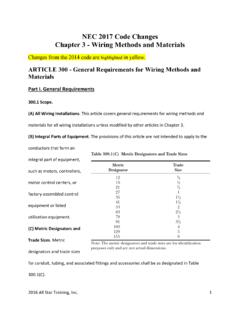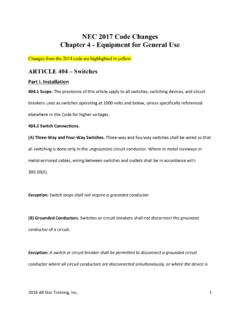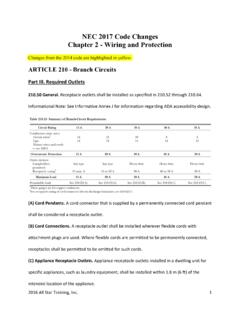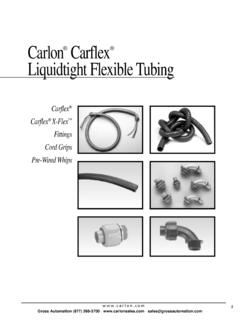Transcription of NEC 2017 Code Changes Chapter 3 - Wiring Methods and …
1 2016 All Star Training, Inc. 1 NEC 2017 Code Changes Chapter 3 - Wiring Methods and Materials Changes from the 2014 code are highlighted in yellow. ARTICLE 300 - General Requirements for Wiring Methods and Materials Part I. General Requirements Mechanical Continuity Raceways and Cables. Raceways, cable armors, and cable sheaths shall be continuous between cabinets, boxes, fittings, or other enclosures or outlets. Exception No. 1: Short sections of raceways used to provide support or protection of cable assemblies from physical damage shall not be required to be mechanically continuous. Exception No. 2: Raceways and cables installed into the bottom of open bottom equipment, such as switchboards, motor control centers, and floor or pad-mounted transformers, shall not be required to be mechanically secured to the equipment. Mechanical and Electrical Continuity Conductors. (A) General. Conductors in raceways shall be continuous between outlets, boxes, devices, and so forth.
2 There shall be no splice or tap within a raceway unless permitted by ; (A); ; ; ; ; ; or (B) Device Removal. In multiwire branch circuits, the continuity of a grounded conductor shall not depend on device connections such as lampholders, receptacles, and so forth, where the removal of such devices would interrupt the continuity. 2016 All Star Training, Inc. 2 Length of Free Conductors at Outlets, Junctions, and Switch Points. At least 150 mm (6 in.) of free conductor, measured from the point in the box where it emerges from its raceway or cable sheath, shall be left at each outlet, junction, and switch point for splices or the connection of luminaires or devices. Where the opening to an outlet, junction, or switch point is less than 200 mm (8 in.) in any dimension, each conductor shall be long enough to extend at least 75 mm (3 in.) outside the opening. Exception: Conductors that are not spliced or terminated at the outlet, junction, or switch point shall not be required to comply with Boxes, conduit Bodies, or Fittings Where Required.
3 A box shall be installed at each outlet and switch point for concealed knob-and-tube Wiring . Fittings and connectors shall be used only with the specific Wiring Methods for which they are designed and listed. Where the Wiring method is conduit , tubing, Type AC cable, Type MC cable, Type MI cable, nonmetallic-sheathed cable, or other cables, a box or conduit body shall be installed at each conductor splice point, outlet point, switch point, junction point, termination point, or pull point, unless otherwise permitted in (A) through (L). (A) Wiring Methods with Interior Access. A box or conduit body shall not be required for each splice, junction, switch, pull, termination, or outlet points in Wiring Methods with removable covers, such as wireways, multioutlet assemblies, auxiliary gutters, and surface raceways. The covers shall be accessible after installation. 2016 All Star Training, Inc. 3 (B) Equipment. An integral junction box or Wiring compartment as part of approved equipment shall be permitted in lieu of a box.
4 (C) Protection. A box or conduit body shall not be required where cables enter or exit from conduit or tubing that is used to provide cable support or protection against physical damage. A fitting shall be provided on the end(s) of the conduit or tubing to protect the cable from abrasion. (D) Type MI Cable. A box or conduit body shall not be required where accessible fittings are used for straight-through splices in mineral-insulated metal -sheathed cable. (E) Integral Enclosure. A Wiring device with integral enclosure identified for the use, having brackets that securely fasten the device to walls or ceilings of conventional on-site frame construction, for use with nonmetallic-sheathed cable, shall be permitted in lieu of a box or conduit body. Informational Note: See (C); ; (I); (E), Exception No. 1; and (E), Exception No. 1. (F) fitting . A fitting identified for the use shall be permitted in lieu of a box or conduit body where conductors are not spliced or terminated within the fitting .
5 The fitting shall be accessible after installation. (G) Direct-Buried Conductors. As permitted in (E), a box or conduit body shall not be required for splices and taps in direct-buried conductors and cables. 2016 All Star Training, Inc. 4 (H) Insulated Devices. As permitted in (B), a box or conduit body shall not be required for insulated devices supplied by nonmetallic-sheathed cable. (I) Enclosures. A box or conduit body shall not be required where a splice, switch, terminal, or pull point is in a cabinet or cutout box, in an enclosure for a switch or overcurrent device as permitted in , in a motor controller as permitted in (A), or in a motor control center. (J) Luminaires. A box or conduit body shall not be required where a luminaire is used as a raceway as permitted in (K) Embedded. A box or conduit body shall not be required for splices where conductors are embedded as permitted in , (D), (B), (A), and (A). (L) Manholes and Handhole Enclosures.
6 A box or conduit body shall not be required for conductors in manholes or handhole enclosures, except where connecting to electrical equipment. The installation shall comply with the provisions of Part V of Article 110 for manholes, and for handhole enclosures. Raceway or Cable to Open or Concealed Wiring . (A) Box, conduit Body, or fitting . A box, conduit body, or terminal fitting having a separately bushed hole for each conductor shall be used wherever a change is made from conduit , electrical metallic tubing, electrical nonmetallic tubing, nonmetallic-sheathed cable, Type AC cable, Type MC cable, or mineral-insulated, metal -sheathed cable and surface raceway Wiring to open Wiring or to concealed knob-and-tube Wiring . A fitting used for this purpose shall contain no taps or splices and shall not be used at luminaire outlets. A conduit body used for this purpose shall contain no taps or splices, unless it complies with (C)(2).
7 2016 All Star Training, Inc. 5 (B) Bushing. A bushing shall be permitted in lieu of a box or terminal where the conductors emerge from a raceway and enter or terminate at equipment, such as open switchboards, unenclosed control equipment, or similar equipment. The bushing shall be of the insulating type for other than leadsheathed conductors. Number and Size of Conductors in Raceway. The number and size of conductors in any raceway shall not be more than will permit dissipation of the heat and ready installation or withdrawal of the conductors without damage to the conductors or to their insulation. Informational Note: See the following sections of this Code: intermediate metal conduit , ; rigid metal conduit , ; flexible metal conduit , ; liquidtight flexible metal conduit , ; PVC conduit , ; HDPE conduit , ; RTRC, ; liquidtight nonmetallic flexible conduit , ; electrical metallic tubing, ; flexible metallic tubing, ; electrical nonmetallic tubing, ; cellular concrete floor raceways, ; cellular metal floor raceways, ; metal wireways, ; nonmetallic wireways, ; surface metal raceways, ; surface nonmetallic raceways, ; underfloor raceways, ; fixture wire, ; theaters, ; signs, (C); elevators, ; audio signal processing, amplification, and reproduction equipment, (A) and ; Class 1, Class 2, and Class 3 circuits, Article 725; fire alarm circuits, Article 760; and optical fiber cables and raceways, Article 770.
8 2016 All Star Training, Inc. 6 Raceway Installations. (A) Complete Runs. Raceways, other than busways or exposed raceways having hinged or removable covers, shall be installed complete between outlet, junction, or splicing points prior to the installation of conductors. Where required to facilitate the installation of utilization equipment, the raceway shall be permitted to be initially installed without a terminating connection at the equipment. Prewired raceway assemblies shall be permitted only where specifically permitted in this Code for the applicable Wiring method. Exception: Short sections of raceways used to contain conductors or cable assemblies for protection from physical damage shall not be required to be installed complete between outlet, junction, or splicing points. (B) Welding. metal raceways shall not be supported, terminated, or connected by welding to the raceway unless specifically designed to be or otherwise specifically permitted to be in this Code.
9 Supporting Conductors in Vertical Raceways. (A) Spacing Intervals Maximum. Conductors in vertical raceways shall be supported if the vertical rise exceeds the values in Table (A). At least one support method shall be provided for each conductor at the top of the vertical raceway or as close to the top as practical. Intermediate supports shall be provided as necessary to limit supported conductor lengths to not greater than those values specified in Table (A). 2016 All Star Training, Inc. 7 Exception: Steel wire armor cable shall be supported at the top of the riser with a cable support that clamps the steel wire armor. A safety device shall be permitted at the lower end of the riser to hold the cable in the event there is slippage of the cable in the wire-armored cable support. Additional wedge-type supports shall be permitted to relieve the strain on the equipment terminals caused by expansion of the cable under load. (B) Fire-Rated Cables and Conductors.
10 Support Methods and spacing intervals for fire-rated cables and conductors shall comply with any restrictions provided in the listing of the electrical circuit protective system used and in no case shall exceed the values in Table (A). (C) Support Methods . One of the following Methods of support shall be used: (1) By clamping devices constructed of or employing insulating wedges inserted in the ends of the raceways. Where clamping of insulation does not adequately support the cable, the conductor also shall be clamped. 2016 All Star Training, Inc. 8 (2) By inserting boxes at the required intervals in which insulating supports are installed and secured in an approved manner to withstand the weight of the conductors attached thereto, the boxes being provided with covers. (3) In junction boxes, by deflecting the cables not less than 90 degrees and carrying them horizontally to a distance not less than twice the diameter of the cable, the cables being carried on two or more insulating supports and additionally secured thereto by tie wires if desired.








